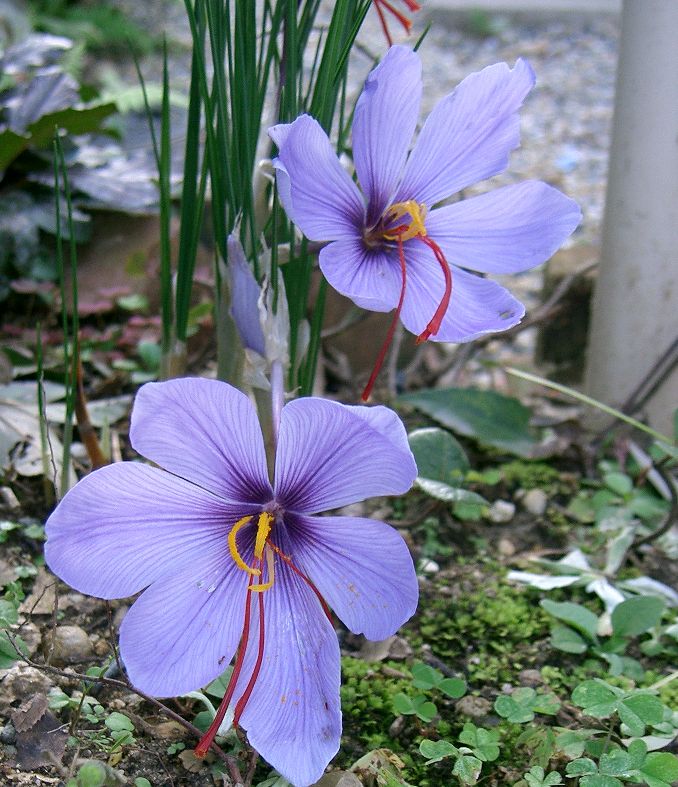Saffron
The Basics
Let me start by saying that of all the spices I’ve reviewed saffron is by far the most complex and varied.
Saffron is the most expensive spice on the planet (with the exception of ambergris, but calling that a spice is a bit of stretch). Saffron is the name for the dried, deeply colored, reddish-orange filaments from the saffron crocus flower (Crocus sativus). It takes up to 75,000 of these hand-picked filaments to produce one pound of saffron. Moreover, the filaments must be harvested must be between dawn and 10am, since the stigmas lose colour and aroma if left too long in the plant.
Saffron is the name for the dried, deeply colored, reddish-orange filaments from the saffron crocus flower (Crocus sativus). It takes up to 75,000 of these hand-picked filaments to produce one pound of saffron. Moreover, the filaments must be harvested must be between dawn and 10am, since the stigmas lose colour and aroma if left too long in the plant.
These filaments are the female reproductive organs of the crocus which has certainly contributed to saffron’s aphrodisiac and medicinal history. Saffron also imparts a lovely luminous gold color into its dishes.
Like most spices, saffron quality varies depending on where it’s grown, the variety and how its harvested. Spain, India and Iran are well-known saffron producers. Most saffron we use in the U.S. comes from spice retailers selling Spanish saffron.
One gram of Spanish saffron ranges from $8.50-$14.00/gram (depending on quality).
One pound can easily cost up to $2000.
You can also purchase saffron in increments as small as 1/2 gram for $7.00 (from My Spice Sage).
Fortunately, saffron is a potent spice and only a small pinch is needed in a recipe. A gram of saffron will be plenty to season 6-8 dishes.
The Form
Saffron is dried and comes in whole or powdered form. It’s preferable to purchase the whole stigmas. Not only do powdered spices loose their potency more quickly but because saffron is so valueable the powdered form is more vulnerable to being adultrated. One practice involves including the yellow filaments which contain no flavor. Expect to pay more for a higher count of pure red threads. Look carefully, you can see a few yellow threads in the photo to the right. It’s perfectly normal to expect some yellow threads.
However, powdered form can be cut with turmeric or safflower. Be sure to purchase from a reputable spice merchant who knows who knows the reputation of their saffron provider. As I did research for this piece I ran across Spanish Mancha saffron which is a highly reputable saffron supplier to spice merchants. So ask.
The Flavor
Subtle, honey, floral, perfumed, grassy, reminiscent of hay. Saffron has many descriptions and somehow all are rather accurate. This spice is is uniquely its own. It’s the star flavor in Spanish paella, many Indian and Middle Eastern dishes. It pairs well with white wine, seafood and vegetables. I provided a popular Italian sauce that uses nothing but zuchini, salt, and saffron.
In addition to having over 150 aroma and flavor compounds saffron quality and flavor is graded on complicatd mathematical equation calculating color, weight and fragrance. It factors in both the stigmas (filaments) and the other portions of the flower.
The Story
I tried. I really did try to offer a summary of this history of this spice. Not only is it probably the world’s oldest cultivated spice with a documented history of use of spanning over 4,000 years but it’s celebrated across multiple cultures and an array of medicinal uses. It was like harnessing an information tidal wave. Then I happily discovered The Spice House’s excellent summary. If you want to read the following saffron info directly from the source, go here.
- The Greeks considered saffron to be the essence of youth and life, a proper gift for newlyweds.
- Phoenician newlyweds slept on pillows strewn with saffron.
- Ancient Chinese attributed saffron with considerable medicinal properties and drank it as a tea for almost any ailment. Modern Chinese still use it in medicinal respects as a catalyst for healing power when mixed with other herbs.
- Romans used it to perfume public places in need of olfactory improvement.
- An Asian custom also uses saffron for its scent by welcoming guests when they arrive by sprinkling saffron over their clothes.
- In India, the traditional caste markings of wealthy people were saffron-colored. Because saffron is so expensive it is rarely used as a dye in modern times, except in special circumstances, Indian women still often dye their wedding gowns and veils with saffron’s luminscent golden hue.
Try It!
Zuchini Saffron Sauce
In addition to sprinkling saffron on seafood and using it to season rice, saffron pairs beautifully with vegetables. Here is a recipe for a zuchini, salt, saffron sauce. Something about the earthy, floral perfume of the saffron balances the zuchnini’s bitterness.
There are 4 ingredients:
- 3 cups of very thinly sliced zuchini.
- A pinch of saffron threads.
- A pinch of salt.
- olive oil
- In a heavy bottomed skillet pour approximately 2-3 tablespoons olive oil. Add the zuchini, salt and saffron threads.
- Over a very low, very low flame stir the ingredients until mixed and coated with olive oil.
- Let cook and stir occasionally for several hours.
You will be left with a golden-tinged softened zuchini mush. It’s delicious. Use it as a sauce over pasta. Please don’t be tempted to do anything silly like add sausage or complicate this recipe in any other way. The beauty is its simplicity and pure expression of the saffron and zuchini. Buon Apetito!




4 Pingbacks